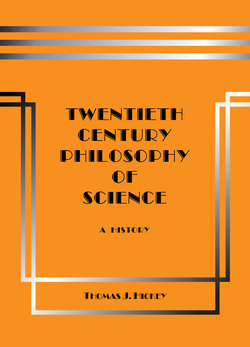Читать книгу Twentieth-Century Philosophy of Science: A History (Third Edition) - Thomas J. Hickey - Страница 118
На сайте Литреса книга снята с продажи.
Scientific Criticism
ОглавлениеDuhem developed a sophisticated theory of scientific criticism, and it is central to his philosophy of science. He is very emphatic in defending the autonomy of empirical science from any encroachment by metaphysics or natural philosophy. Metaphysics pertains to realities that underlie the phenomenal appearances hidden by the phenomena, while science pertains only to these appearances. Consequently whatever may be the criteria and procedures for criticizing a metaphysical thesis, they are not relevant to empirical science. In empirical sciences that are nonmathematical, the generalizations such as “Every man is mortal” may be accepted or rejected as simply true or false. But in mathematical physics the equations both of the empirical laws and of the hypothetical theories are not simply regarded as true or false, but are approximate. The amount of underdetermination due to the approximate nature of the values of the variables in these equations will be reduced as experimental and measurement techniques improve. And because measurement instruments depend on physical theory, the improvement in instruments occurs due to the improvement in theory. As the range of this indeterminacy becomes smaller, the equations of either the empirical laws or the hypothetical theories that represent the laws may no longer be able to predict values for their variables that fall within the smaller range of measurement error. When this happens, the equations are no longer satisfactory. Duhem maintains that the only criterion that may validly operate in scientific criticism is the ability of the law or theory to make accurate predictions. This exclusion of all prior ontological or metaphysical criteria from scientific criticism has been carried forward into the contemporary pragmatist philosophy of science. It shows up for example as Quine’s rejection of all “first philosophy.”
In his theory of scientific criticism Duhem rejected the use of so-called crucial experiments as a means of establishing the validity of a theory. His thesis is that if the physicist is confronted with several alternative theories, the rejection of all but one cannot imply the establishment of the remaining one. As an example he cites the two alternative theories of light: one theory is the hypothesis that light is a stream of high speed projectiles, and the other is the hypothesis that light consists of vibrations whose waves are propagated in ether. This is not an anticipation of the Copenhagen duality thesis; Duhem is thinking of the wave and particle theories as alternative theories. His position is that the choice is not mutually exclusive, because no one can ever enumerate completely all of the various hypotheses, which may pertain to a group of phenomena. He thus maintains that several alternative theories may fall within the range of indeterminacy of the measurement data and experimental laws, so that more than one theory may be satisfactory. This represents a pluralistic thesis about science, and in the crucial experiment discussion, it means that even if all hypotheses could somehow be enumerated, elimination could not leave but one to be considered as established. This pluralism is another aspect of his philosophy of physical theory that has been carried forward into the contemporary pragmatist philosophy of science.
His theory of scientific criticism also reflects his wholistic view of theories. This wholistic view not only makes the meanings of the mathematical symbols mutually determined by the context consisting of the equations of the theory, it also necessitates testing the theory as a whole together with all the hypotheses used in the experiment including assumptions about the measuring instruments. Thus if the prediction in the test is wrong, not only may the proposition being tested be at fault, but also the whole theoretical scaffolding used by the physicist. The physicist can never subject an isolated hypothesis to experimental test, but only a whole group of hypotheses. The only thing that the experiment reveals is that among all the theoretical propositions used to predict the phenomenon, there is at least one error. Thus the failure of the prediction does not inform the physicist where the error lies or reveal which hypothesis should be modified.
In Duhem’s view physics is not like a machine which lets itself be disassembled; the physicist cannot test each piece in isolation and then make adjustments to the isolated part found wanting. Duhem compares physics to an organism in which one part cannot be made to function except when the parts that are most remote from it are called into play. When there is a malfunction felt in the organism, the physician must ferret out through its effects on the entire system, the organ that needs to be remedied or modified without the possibility of isolating the organ and examining it apart. Duhem says that the physicist confronted with a failed prediction is more like a physician than a watchmaker.
